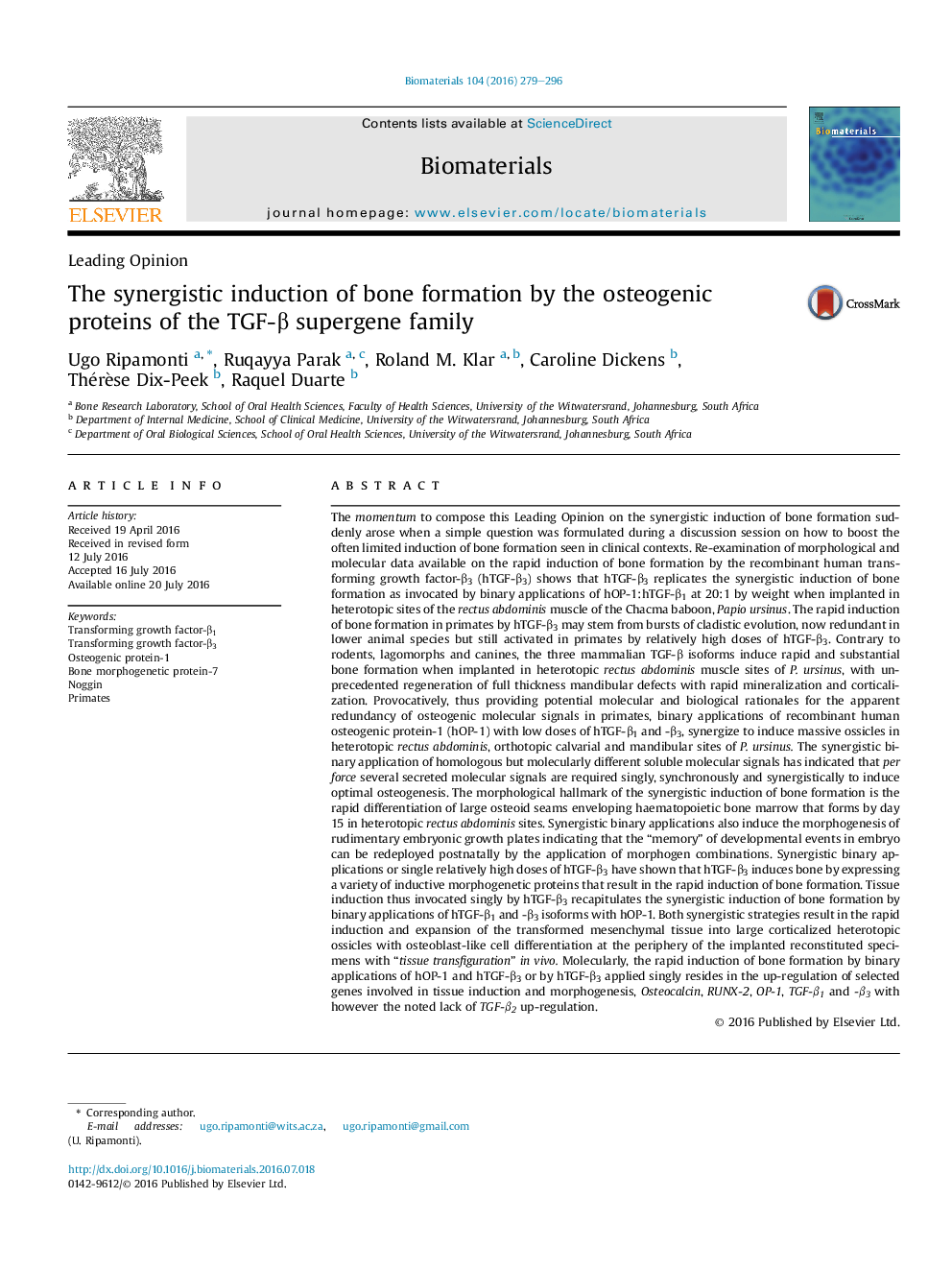| کد مقاله | کد نشریه | سال انتشار | مقاله انگلیسی | نسخه تمام متن |
|---|---|---|---|---|
| 6484813 | 364 | 2016 | 18 صفحه PDF | دانلود رایگان |
عنوان انگلیسی مقاله ISI
The synergistic induction of bone formation by the osteogenic proteins of the TGF-β supergene family
دانلود مقاله + سفارش ترجمه
دانلود مقاله ISI انگلیسی
رایگان برای ایرانیان
کلمات کلیدی
موضوعات مرتبط
مهندسی و علوم پایه
مهندسی شیمی
بیو مهندسی (مهندسی زیستی)
پیش نمایش صفحه اول مقاله

چکیده انگلیسی
The momentum to compose this Leading Opinion on the synergistic induction of bone formation suddenly arose when a simple question was formulated during a discussion session on how to boost the often limited induction of bone formation seen in clinical contexts. Re-examination of morphological and molecular data available on the rapid induction of bone formation by the recombinant human transforming growth factor-β3 (hTGF-β3) shows that hTGF-β3 replicates the synergistic induction of bone formation as invocated by binary applications of hOP-1:hTGF-β1 at 20:1 by weight when implanted in heterotopic sites of the rectus abdominis muscle of the Chacma baboon, Papio ursinus. The rapid induction of bone formation in primates by hTGF-β3 may stem from bursts of cladistic evolution, now redundant in lower animal species but still activated in primates by relatively high doses of hTGF-β3. Contrary to rodents, lagomorphs and canines, the three mammalian TGF-β isoforms induce rapid and substantial bone formation when implanted in heterotopic rectus abdominis muscle sites of P. ursinus, with unprecedented regeneration of full thickness mandibular defects with rapid mineralization and corticalization. Provocatively, thus providing potential molecular and biological rationales for the apparent redundancy of osteogenic molecular signals in primates, binary applications of recombinant human osteogenic protein-1 (hOP-1) with low doses of hTGF-β1 and -β3, synergize to induce massive ossicles in heterotopic rectus abdominis, orthotopic calvarial and mandibular sites of P. ursinus. The synergistic binary application of homologous but molecularly different soluble molecular signals has indicated that per force several secreted molecular signals are required singly, synchronously and synergistically to induce optimal osteogenesis. The morphological hallmark of the synergistic induction of bone formation is the rapid differentiation of large osteoid seams enveloping haematopoietic bone marrow that forms by day 15 in heterotopic rectus abdominis sites. Synergistic binary applications also induce the morphogenesis of rudimentary embryonic growth plates indicating that the “memory” of developmental events in embryo can be redeployed postnatally by the application of morphogen combinations. Synergistic binary applications or single relatively high doses of hTGF-β3 have shown that hTGF-β3 induces bone by expressing a variety of inductive morphogenetic proteins that result in the rapid induction of bone formation. Tissue induction thus invocated singly by hTGF-β3 recapitulates the synergistic induction of bone formation by binary applications of hTGF-β1 and -β3 isoforms with hOP-1. Both synergistic strategies result in the rapid induction and expansion of the transformed mesenchymal tissue into large corticalized heterotopic ossicles with osteoblast-like cell differentiation at the periphery of the implanted reconstituted specimens with “tissue transfiguration” in vivo. Molecularly, the rapid induction of bone formation by binary applications of hOP-1 and hTGF-β3 or by hTGF-β3 applied singly resides in the up-regulation of selected genes involved in tissue induction and morphogenesis, Osteocalcin, RUNX-2, OP-1, TGF-β1 and -β3 with however the noted lack of TGF-β2 up-regulation.
ناشر
Database: Elsevier - ScienceDirect (ساینس دایرکت)
Journal: Biomaterials - Volume 104, October 2016, Pages 279-296
Journal: Biomaterials - Volume 104, October 2016, Pages 279-296
نویسندگان
Ugo Ripamonti, Ruqayya Parak, Roland M. Klar, Caroline Dickens, Thérèse Dix-Peek, Raquel Duarte,